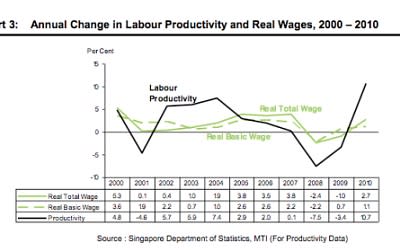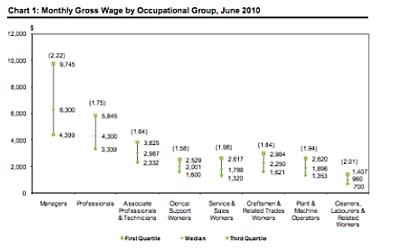Are Singaporeans working more for less?

A strong economy and tightening labour market saw private sector workers' wages grow last year, said the Ministry of Manpower (MOM).
But with a significant leap in labour productivity, did the wage increase keep pace?
The MOM's latest findings show total wages, which comprise of basic wages and the annual variable component, rose by 5.5 percent in 2010, after contracting by 0.4 percent the year before.
After accounting for inflation, real total wages rose by 2.7 percent in 2010, after declining by 1 percent in 2009.
Labour productivity increased significantly by 11 percent in 2010, after two years of declines, reported the MOM. The Ministry attributed the increase to a "robust GDP growth".
The difference in the wage increase and productivity climb has seen one recruitment consultancy question if employees are now "working more for less".
"The real wage increase is only 2.7 per cent at the back of a significant market recovery post-global financial crisis in 2009," Robert Walters Singapore's director of Financial Services & Legal Pan Zaixian pointed out.
It is "not a considerable wage increment" after taking into consideration the 11 percent increase in productivity, he said. "It seems that the higher increase in output has not translated much more in real wage increment terms."
"Hence, the question is -- are we working for less?" he asked.
Recruitment firm Adecco SEA's regional director Lynne Ng, however, placed the ball in the employees' court by noting that Singapore is "most definitely continuing to be an employee driven market".
She said, "The extremely tight labour market in Singapore with its low unemployment rate is driving up wages and job seeker expectations. Job seekers are holding out for the very best offers and in many cases carefully evaluating several job offers before making a final decision."
"This is very different to the situation in late 2008 and 2009," she added.
Among the industries, higher value-added ones generally paid better, said MOM based on the findings of its occupational wage survey 2010.
The financial services industry was the highest-paying out of many occupational groups, while hotels and restaurants as well as construction sectors were among the lowest-paying industries.
Pan said that since the 2009 financial crisis impacted the financial services industry more than others, the industry thus saw a higher year-on-year increase in wages relative to other industries during the 2010 market recovery.
Ng noted that the sector quickly turned around after the economic challenges of late 2009 and early 2010
Figures show managers continued to command the highest median gross monthly salary at $6,300 in June 2010, while professionals came in second at $4,300. The third-highest paid were the associate professionals and technicians with a median pay of $2,987.
Clerical support workers and service and sales workers earned about $2,000 and $1,788, respectively.
Cleaners, labourers and related workers were the lowest-paid with a median pay of $960. Plant and machine operators were the second-lowest paid with a median salary of $1,896.
The MOM report also found that managers and professionals were more likely to get higher pay as they grow older, while blue-collar and lower-skilled workers' pay peaked early in their 30s.
What are salary expectations for 2011?
"From a percentage increase point of view, I don't foresee higher increases than last year as inflation in Singapore looks to be more contained this year," Pan said.
The market is also more "bottom-line conscious" because of uncertainties in the wider global economies, he added.
On the other hand, Adecco's Ng said she expects to see wages growing in 2011 and that "it will continue to be an employee driven market".
The MOM survey on annual wage changes for 2010 sampled 4,336 private sector establishments with a total of 1,039,100 employees. The survey was conducted using mail questionnaires with clarifications over the phone.
The occupational wage survey 2010 sampled 3,304 private sector establishments, covering some 223,500 CPF contributors in full-time employment. The survey was conducted through mail questionnaires.



